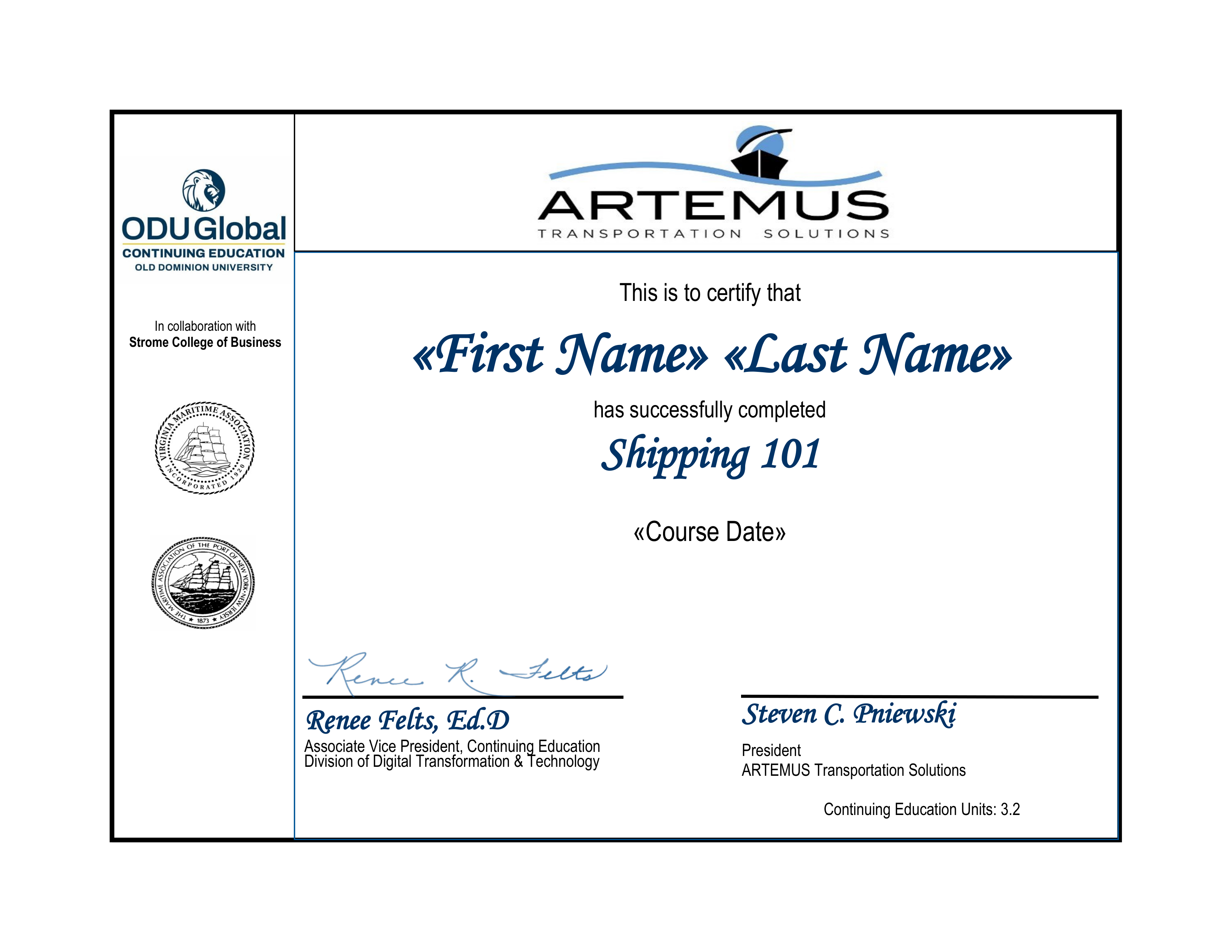Course Overview
Explore the essential skills & knowledge needed for excelling in the customer service & booking departments of the shipping industry.
- Understanding Incoterms
- Booking Record Essentials
- Freight Rate Determination
- Tariffs & Service Contracts
- Shipping Document Examples
- Effective Rate Quoting
What You Will Learn?
This course delves into the crucial aspects of customer service & booking in the shipping industry, covering Incoterms, booking records, freight rates, tariffs, contracts, & essential shipping documents. Gain practical knowledge to enhance your efficiency in managing bookings & customer interactions.
Understanding Incoterms
Gain a comprehensive understanding of Incoterms, including their definitions and how they influence responsibilities, risks, and costs in international shipping agreements.
Booking Record Essentials
Learn the key components of accurate booking records and how this critical information is utilized by various parties to streamline the shipping process.
Freight Rate Determination
Explore the factors that affect freight rate calculations and how to effectively determine and quote competitive rates that meet both company and customer needs.
Tariffs & Service Contracts
Delve into the structure of tariffs and service contracts, uncovering how different rate filings influence shipping costs and customer agreements.
Shipping Document Examples
Review and understand the importance of essential shipping documents, including how they ensure smooth, compliant, and transparent logistics operations.
Effective Rate Quoting
Master the skills needed to quote rates efficiently and accurately, balancing customer satisfaction with profitability and competitiveness.
By Artemus Transportation Solutions
With a dedicated legacy since 2004, Artemus Transportation Solutions has become a trusted leader in transportation compliance solutions, offering cutting-edge ISF, AMS, Customs Broker, & eManifest Canada & Japan AFR software. Our years of hands-on industry experience allow us to deliver impactful training courses that go beyond theory, empowering professionals with real-world knowledge.
- 19+ Years of Expertise in Global Transportation Compliance Solutions.
- Practical, real-world insights into Customs, Import, and Export processes.
- Hands-on training in managing complex transportation equipment logistics.
- Efficient solutions for navigating International Shipping and related challenges.

Recognized Certification From Artemus Transportation Solutions
Upon completing the International Shipping course, you'll receive a Certificate of Completion from Artemus Transportation Solutions. This certification highlights your expertise in global shipping processes & compliance, making it a valuable addition to your skills.

Our Reviews
Frequently Asked Questions
Who Is The Course Designed For?
This course is tailored for professionals at all levels, from beginner to intermediate learners, who are looking to enhance their knowledge of global shipping, logistics, & compliance.
What Topics Are Covered In The Customer Service/Booking Department Course?
The course covers essential skills and knowledge for excelling in the customer service and booking departments of the shipping industry, including Incoterms, booking record essentials, freight rate determination, tariffs, service contracts, shipping documents, and effective rate quoting.
What Are Incoterms, And Why Are They Important In Shipping?
Incoterms are internationally recognized rules that define the responsibilities of buyers and sellers in shipping agreements. Understanding Incoterms is essential for customer service and booking departments to accurately manage shipping costs, delivery terms, and risks.
Will I Receive A Certification Upon Course Completion?
Yes, you’ll receive a Certificate of Completion from Artemus Transportation Solutions, which can be showcased on your professional profiles.
Are The Courses Self-Paced Or Instructor-Led?
This course offers a flexible, self-paced learning format with video pre-recorded lessons, allowing you to complete them at your convenience. This approach enables you to learn at your own pace & revisit material as needed.
Do I Need Prior Experience In Shipping Or Logistics To Take This Course?
While prior experience is helpful, our beginner & intermediate-level courses provide foundational knowledge, making them accessible even for those new to the industry.
How Can This Course Benefit My Career?
By completing this course, you’ll gain practical, real-world insights that can boost your skills, enhance your compliance knowledge, & advance your career in the shipping & logistics industry.
What Makes Artemus’s Customer Service/Booking Department Course Unique?
Artemus’s course combines theoretical knowledge with real-world applications, providing practical insights into the customer service and booking processes in the shipping industry. It covers essential topics like Incoterms, tariff management, and effective rate quoting, equipping learners with the skills needed to excel in their roles and handle real-world challenges efficiently.
Customer Service Course: Discover service-related topics in shipping and logistics
Understanding how to calculate freight rate for shipments
Freight rates are determined by various factors such as shipment weight, dimensions, distance, and mode of transport. Understanding how to calculate freight rates is essential for businesses to estimate costs accurately and optimize logistics expenses. Factors like fuel surcharges, handling fees, and demand fluctuations can impact the final cost. By using freight calculators and obtaining multiple carrier quotes, shippers can find competitive rates. Additionally, understanding Incoterms and customs duties can help in precise calculations. Proper knowledge of freight rate calculations ensures better cost management and efficiency in supply chain operations.
What is freight rate and why does it matter?
A freight rate is the price charged by a carrier to transport goods from one location to another. It is a crucial component in global trade and logistics, influencing shipping costs and profitability. Freight rates vary based on factors like shipment size, weight, distance, and carrier type. Businesses must understand freight rates to budget shipping expenses effectively. Competitive freight rates can help businesses optimize supply chain efficiency. Monitoring rate trends ensure businesses remain competitive in the global market.
Step-by-step guide: how do you calculate freight rates?
Calculating freight rates involves several steps, starting with determining the shipment's weight and volume. Next, shippers must choose the appropriate transport mode—air, sea, rail, or road. Distance plays a key role, as longer routes generally have higher costs. Additional surcharges such as fuel costs, customs duties, and peak season fees should be factored in. Many companies use online freight calculators to get instant rate estimates. Comparing multiple carrier quotes ensures the best deal for cost-effective shipping. Understanding these steps helps businesses streamline logistics planning.
Will freight rates go up in 2024? market predictions
Freight rates fluctuate due to market conditions, fuel prices, and global supply chain disruptions. Experts predict that in 2024, rates may be influenced by economic recovery, inflation, and geopolitical factors. A rise in fuel costs and labor shortages could drive freight rates higher. Conversely, improved logistics infrastructure and increased competition among carriers may stabilize prices. Shippers should monitor industry trends and secure favorable contracts early. Planning ahead and optimizing supply chains can mitigate potential cost increases.
How freight rates are determined: key factors to consider
Several factors influence freight rates, including shipment weight, volume, distance, and transport mode. Fuel prices and carrier demand can also cause rate fluctuations. Customs duties and tariffs affect international shipments, adding extra costs. Seasonal demand spikes, such as holiday periods, often lead to higher freight rates. Understanding these factors helps businesses negotiate better shipping rates. Leveraging technology and data analytics can optimize freight cost management.
Best practices on how to calculate freight rates efficiently
To calculate freight rates accurately, businesses should measure cargo dimensions and weight precisely. Using online freight calculators can simplify rate estimation. Comparing quotes from multiple carriers ensures cost-effectiveness. Understanding Incoterms and customs regulations helps in avoiding hidden fees. Consolidating shipments reduces per-unit shipping costs. Regularly reviewing freight invoices prevents overcharges and improves cost control.
Essential shipping documents for smooth logistics
Shipping documents ensure compliance, facilitate customs clearance, and verify shipment details. Common documents include the Bill of Lading, Packing List, and Commercial Invoice. Proper documentation minimizes delays and legal issues. Shippers should maintain accurate records for tracking and auditing purposes. Digital documentation enhances efficiency and reduces paperwork errors. Ensuring all required shipping documents are in place prevents costly disruptions.
Complete guide to documents for shipping international orders
International shipping requires specific documents for customs clearance and regulatory compliance. Key documents include the Bill of Lading, Certificate of Origin, and Import/Export Declaration. Accurate documentation helps avoid shipment delays and penalties. Understanding country-specific requirements ensures smooth cross-border transactions. Using digital platforms streamlines document management. Keeping copies of all shipping documents aids in dispute resolution.
Understanding shipping documentation and its importance
Shipping documentation serves as proof of transaction, legal compliance, and shipment details. Essential documents include invoices, waybills, and customs declarations. Proper documentation ensures smooth shipping and minimizes compliance risks. Incorrect or missing documents can lead to shipment delays and additional costs. Digital documentation enhances accuracy and accessibility. Businesses should train staff on proper document handling for seamless logistics.
Shipping documents for overseas shipments: what you need
Overseas shipments require documents like the Bill of Lading, Packing List, and Certificates of Compliance. These documents facilitate smooth customs clearance and shipment tracking. Accurate documentation prevents legal issues and shipment delays. Electronic submission of documents speeds up the shipping process. Different countries have specific requirements, so shippers must stay informed. Ensuring completeness of paperwork improves international trade efficiency.
What is a tariff? understanding its role in trade
A tariff is a tax imposed on imported or exported goods by a country’s government. Tariffs regulate trade, protect domestic industries, and generate revenue. Import tariffs can increase the cost of foreign goods, influencing consumer choices. Export tariffs are less common but may be applied to control resource depletion. Understanding tariff structures helps businesses calculate total import/export costs. Staying updated on tariff policies ensures compliance with trade regulations.
Harmonized tariff code: what it is and how it works
The Harmonized Tariff Code (HTC) is an internationally standardized system for classifying traded products. It determines customs duties and import/export restrictions. Each product has a unique HTC, facilitating global trade compliance. Customs authorities use HTCs to verify and assess duties on shipments. Proper classification under HTCs prevents penalties and shipment delays. Businesses must ensure accurate product classification for cost efficiency.
What are tariffs? a comprehensive guide
Tariffs are government-imposed duties on imported or exported goods. They influence trade balance, economic policies, and pricing strategies. Tariffs can be ad valorem (percentage-based) or specific (fixed charge per unit). Protectionist tariffs aim to safeguard domestic industries from foreign competition. Understanding tariff types helps businesses develop cost-effective trade strategies. Global trade agreements often impact tariff rates and exemptions.
Harmonized tariff schedule explained for importers and exporters
The Harmonized Tariff Schedule (HTS) categorizes goods for customs purposes. It determines applicable duties and trade restrictions. Businesses must classify products accurately to comply with customs regulations. HTS codes impact import/export pricing and duty calculations. Regular updates to the HTS require businesses to stay informed. Proper usage of HTS codes streamlines international shipping and avoids penalties.
Decoding the HS Tariff Code and its importance
The HS Tariff Code is an internationally recognized system for classifying traded goods. It helps governments track trade data, enforce regulations, and determine import duties. Businesses must accurately assign HS codes to their products to comply with trade laws. Consulting with trade compliance experts can prevent misclassification issues.
Understanding the harmonized tariff schedule for global trade
The Harmonized Tariff Schedule (HTS) is essential for international trade compliance. It standardizes product classification across countries and determines applicable duties. Businesses must stay updated on HTS modifications to avoid shipment delays. Proper tariff classification enhances supply chain efficiency and cost predictability.
Harmonized tariff: a key tool for international trade compliance
Harmonized tariffs facilitate global trade by providing a unified classification system. They help businesses determine import/export duties and meet regulatory requirements. Ensuring proper tariff classification minimizes legal risks and operational disruptions. Companies should utilize trade compliance tools for accurate tariff calculations.
How to Use Harmonized Tariff Codes for Import/Export
Businesses use harmonized tariff codes to determine customs duties, import restrictions, and trade compliance requirements. Proper classification prevents shipment delays and penalties. Online tariff databases can help exporters and importers find the correct codes. Regular updates on tariff regulations ensure seamless trade operations.
Shipping incoterms: essential rules for international trade
Incoterms define responsibilities between buyers and sellers in international transactions. They determine shipping costs, insurance obligations, and risk transfer points. Understanding Incoterms ensures clear contract terms and prevents disputes. Businesses must select appropriate Incoterms based on their shipping needs.
FCA incoterms and customs clearance: what you need to know
FCA (Free Carrier) Incoterms specify that sellers are responsible for delivering goods to a carrier chosen by the buyer. This term applies to multiple transport modes and simplifies customs procedures. Understanding FCA Incoterms helps businesses optimize their logistics strategies.
Contract compliance services: ensuring smooth business operations
Contract compliance services help businesses meet legal and regulatory requirements in trade agreements. These services include auditing contracts, verifying supplier obligations, and ensuring regulatory compliance. Proper contract management reduces legal risks and enhances supply chain efficiency.
FAQs
-
What is a freight rate?
A freight rate is the cost charged by a carrier for transporting goods from one location to another. It depends on factors such as shipment weight, distance, mode of transport, and additional surcharges.
-
How are freight rates calculated?
Freight rates are calculated based on shipment weight or volume, transportation mode (air, sea, or land), fuel costs, and additional charges like customs duties, handling fees, and insurance.
-
Will freight rates increase in 2024?
Freight rates fluctuate based on fuel prices, supply chain disruptions, global trade demand, and economic conditions. While predictions indicate potential increases, monitoring market trends is crucial for accurate forecasting.
-
What documents are required for international shipping?
Common documents include a commercial invoice, bill of lading (BOL), packing list, certificate of origin, and customs declaration. Additional documents may be required depending on the destination country.
-
Why is proper shipping documentation important?
Accurate shipping documentation ensures smooth customs clearance, reduces delays, prevents fines, and helps maintain compliance with international trade regulations.
-
How can I obtain the required shipping documents?
Most shipping documents are provided by the seller, freight forwarder, or carrier. Ensure you have all the necessary paperwork before shipping to avoid customs issues.
-
What is a tariff, and how does it affect shipping?
A tariff is a tax imposed on imported or exported goods. It affects shipping costs by increasing the total expense of international trade, depending on the product classification and trade agreements.
-
What is the Harmonized Tariff Code?
The Harmonized Tariff Code is a standardized system for classifying traded goods. It helps determine applicable customs duties and ensures compliance with global trade regulations.
-
How do I find the right HS Tariff Code for my goods?
You can check the official Harmonized Tariff Schedule of your country or consult a customs broker to ensure proper classification and avoid incorrect duty charges.
-
What are Incoterms, and why are they important?
Incoterms (International Commercial Terms) are globally recognized rules that define the responsibilities of buyers and sellers in international trade. They determine who covers shipping costs, risks, and customs duties.
-
Which Incoterms should I use for my shipment?
The best Incoterms depend on factors like shipping method, buyer-seller agreements, and cost allocation. Common ones include FOB (Free on Board), CIF (Cost, Insurance, and Freight), and EXW (Ex Works).
-
How do FCA Incoterms affect customs clearance?
FCA (Free Carrier) means the seller delivers goods to the carrier at a designated place, after which the buyer takes responsibility. This term simplifies customs clearance by clearly defining handover points.
-
What are contract compliance services in shipping?
Contract compliance services ensure that shipping agreements, tariffs, and Incoterms are properly followed, minimizing financial risks and legal issues in global trade.
 L O A D I N G . . .
L O A D I N G . . .














